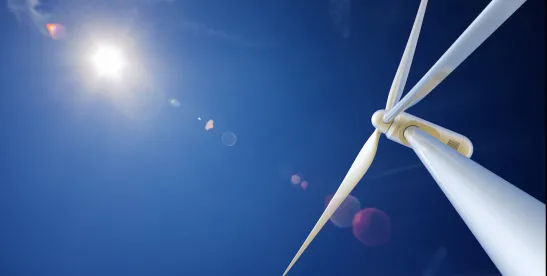On 15 August 2025 the Internal Revenue Service (IRS) released Notice 2025-42 (the Notice), which restricts the methods that developers of wind and solar projects can use to determine whether they have begun construction for purposes of the section 45Y production credit and the section 48E investment credit on and after 2 September 2025. The beginning of construction determination is significant because, following passage of the One Big Beautiful Bill Act (the OBBBA), wind and solar projects that are not placed in service by 31 December 2027 must begin construction prior to 5 July 2026 (the BOC Deadline) to be eligible for section 45Y and section 48E tax credits.
The Notice removes (except for low-output solar facilities) the 5% Safe Harbor (as defined below) for beginning of construction that existed under prior IRS guidance, and it removes the ability to rely upon “continuous efforts” (rather than “continuous construction”) under the related continuity requirement. The Notice was issued in response to Executive Order 14315, in which President Donald Trump directed the US Department of the Treasury to “strictly enforce” the phaseout of the clean electricity production and investment tax credits for wind and solar projects and to issue new and revised guidance to ensure that wind and solar projects did not circumvent the beginning of construction requirement.
Under the Notice, the sole manner (except for low-output solar facilities) by which developers can demonstrate that construction of a wind or solar project has begun by the BOC Deadline is by satisfying a facts-and-circumstances test that requires the taxpayer to commence physical work of a significant nature on the project (the Physical Work Test). The Physical Work Test continues to include both on-site activities1 and off-site activities,2 whether performed by the taxpayer or by a third party pursuant to a binding written agreement, and it continues to exclude production of components that are normally held in inventory.
Consistent with IRS guidance prior to 2021, the Notice requires taxpayers to maintain a continuous construction program after beginning construction (the Continuity Requirement), and it includes a safe harbor under which the Continuity Requirement is satisfied if the facility is placed in service by the end of the fourth calendar year after construction began. The Notice leaves intact the list of generally accepted excusable construction disruptions (weather, permitting delays, interconnection delays, etc.) that may halt construction without violating the Continuity Requirement. However, the Notice eliminates the ability of a taxpayer to satisfy the Continuity Requirement through “continuous efforts” (which included, for example, entering into binding equipment contracts and obtaining permits), which had been extended in 2021 to projects relying on the Physical Work Test and generally was viewed as less stringent than the “continuous construction” test (which requires “continuing physical work of a significant nature”).
While prior guidance had permitted clean energy facilities (including wind and solar projects) to use a safe harbor under which construction was considered to have begun if a taxpayer had paid or incurred 5% or more of the total cost of the facility (the 5% Safe Harbor), the Notice limits use of the 5% Safe Harbor by wind and solar facilities to low-output solar facilities, defined as facilities with an output no greater than 1.5 MW.
The Notice applies to wind and solar facilities, the construction of which does not begin (as determined under section 5 of Notice 2022-61) prior to 2 September 2025. Wind and solar facilities that began construction prior to 2 September 2025 (including those that satisfied the 5% Safe Harbor prior to such date), or that are placed in service by 31 December 2027, will not be impacted by the Notice. In addition, other types of clean energy facilities (e.g., nuclear and battery storage) are not directly impacted by the Notice.
Although the changes effectuated by the Notice are significant, they are not as limiting as much of the wind and solar industry had feared. In addition, because many developers were already using the Physical Work Test instead of the 5% Safe Harbor, and because the four-year safe harbor for the Continuity Requirement was retained, the actual impact of the changes remains to be seen.
The IRS specifically noted that the Notice does not apply to the beginning of construction test for purposes of new provisions under the OBBBA applicable to wind, solar, and other clean energy projects regarding “Foreign Entities of Concern” (FEOC), including, for example, restrictions on direct labor and material costs from prohibited foreign entity sources for facilities beginning construction after 31 December 2025. Those OBBBA provisions specify that beginning of construction for purposes of those requirements (which the IRS specifically referred to in a footnote in the Notice as “separate beginning of construction rules”) be determined in accordance with rules “similar” to prior IRS beginning-of-construction guidance. It remains to be seen whether the IRS will distinguish wind and solar projects from other clean energy projects under these additional forthcoming beginning-of-construction rules.
The Notice is almost certainly not the last guidance that will be released by the IRS to implement the OBBBA changes to clean energy tax credits. The Notice specifically states that FEOC guidance, which was also supposed to be issued by 18 August 2025, will be forthcoming. New and reopened regulatory projects, notices, and other subregulatory guidance, as well as IRS forms and procedures, are expected. Please contact any of the authors of this alert with questions about the bill and to discuss how to engage in the forthcoming guidance process.
1 See Section 3.03(2) of the Notice for a nonexclusive list of examples of on-site physical work of a significant nature:
- Applicable wind facility: work such as beginning of the excavation for the foundation, setting of anchor bolts into the ground, or pouring of the concrete pads of the foundation. If the wind turbines and tower units are assembled on-site from components manufactured off-site by a third party, physical work of a significant nature begins when the off-site manufacture of those components begins, but only if: (i) the manufacturer’s work is done under a binding written contract, and (ii) these components are not held in the manufacturer’s inventory.
- Applicable solar facility: work such as installing racks or other structures to affix photovoltaic panels, collectors, or solar cells to the site.
2 See Section 3.03(1) of the Notice. Off-site physical work of a significant nature may include the manufacture of components: mounting equipment; support structures, such as racks and rails, inverters, and transformers (used in electrical generation that step up the voltage to less than 69 kilovolts); and other power-conditioning equipment.
Michael W. Evans, David J. Skillman, and Rebecca J. Kim contributed to this article.







 />i
/>i

